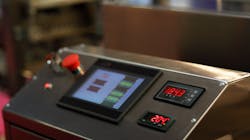Keith Moyer is vice president of sales at Weintek USA.
What have been the biggest improvements to operator-interface technology in the past five years?
Additionally, the ability to add programmable-logic-controller (PLC) functionality a la carte gives enormous flexibility to engineers. By adding a CoDeSys license to the human-machine interface (HMI), engineers can now utilize logic functionality that previously would have required a dedicated PLC. And since CoDeSys is an IEC 61131 standard programming language, transitioning is much simpler than most realize.
What’s the most innovative or efficient operator-interface technology application you’ve ever seen or been involved with?
Keith Moyer, vice president of sales, Weintek USA: Our customers continuously amaze me with their engineering prowess and creativity. It is hard to pick a single one. Generally speaking, the projects that push the advances in technology are the ones that stick in my mind. Using our HMIs to push message-queuing-telemetry-transport (MQTT) data to the cloud, our JavaScript (JS) object technology being used to manipulate 3D objects or customers that utilize our remote-access functionality to service machinery from afar.
How has operator-interface technology benefitted from remote monitoring and connectivity?
Keith Moyer, vice president of sales, Weintek USA: The ability to access our HMIs over the local network has been a huge advantage to those completing factory-acceptance testing (FAT) or commissioning. This feature, either through standard virtual-network computing (VNC) or through an app, gives a lot of flexibility in those situations where monitoring or troubleshooting does not lend itself to being right in front of the HMI.
Additionally, secure remote access, particularly with pass-through capabilities has been a game-changer for equipment manufacturers needing to make changes, handle upgrades or troubleshoot a machine from home base. This saves time and money for both the machine manufacturer and the customer.
Can you explain how software development has changed operator interfaces in manufacturing?
Keith Moyer, vice president of sales, Weintek USA: Our HMIs have become increasingly more powerful with more advanced features allowing engineers to design more functionality into the HMIs, reducing the load on the PLC. Capabilities such as JS objects, macros and scripting are allowing more complex utilization of the HMI's processing power. This additional processing power and advancement in feature sets of the HMI is adding immense capabilities for engineers and allowing the HMI to carry more of the workload.
Tell us about your company’s state-of-the-art operator-interface technology for manufacturing.
Keith Moyer, vice president of sales, Weintek USA: Our cMT3162X integrates speed and processing power with advanced features and a full HD capacitive touchscreen. This includes touch features that we have become accustomed to on our phones and tablets. With features such as database server, OPC UA server, SQL Query and a PLC Web Browser, our customers have the flexibility they need to create projects for even the toughest applications.
About the Author
Mike Bacidore
Editor in Chief
Mike Bacidore is chief editor of Control Design and has been an integral part of the Endeavor Business Media editorial team since 2007. Previously, he was editorial director at Hughes Communications and a portfolio manager of the human resources and labor law areas at Wolters Kluwer. Bacidore holds a BA from the University of Illinois and an MBA from Lake Forest Graduate School of Management. He is an award-winning columnist, earning multiple regional and national awards from the American Society of Business Publication Editors. He may be reached at [email protected]

Leaders relevant to this article:


